





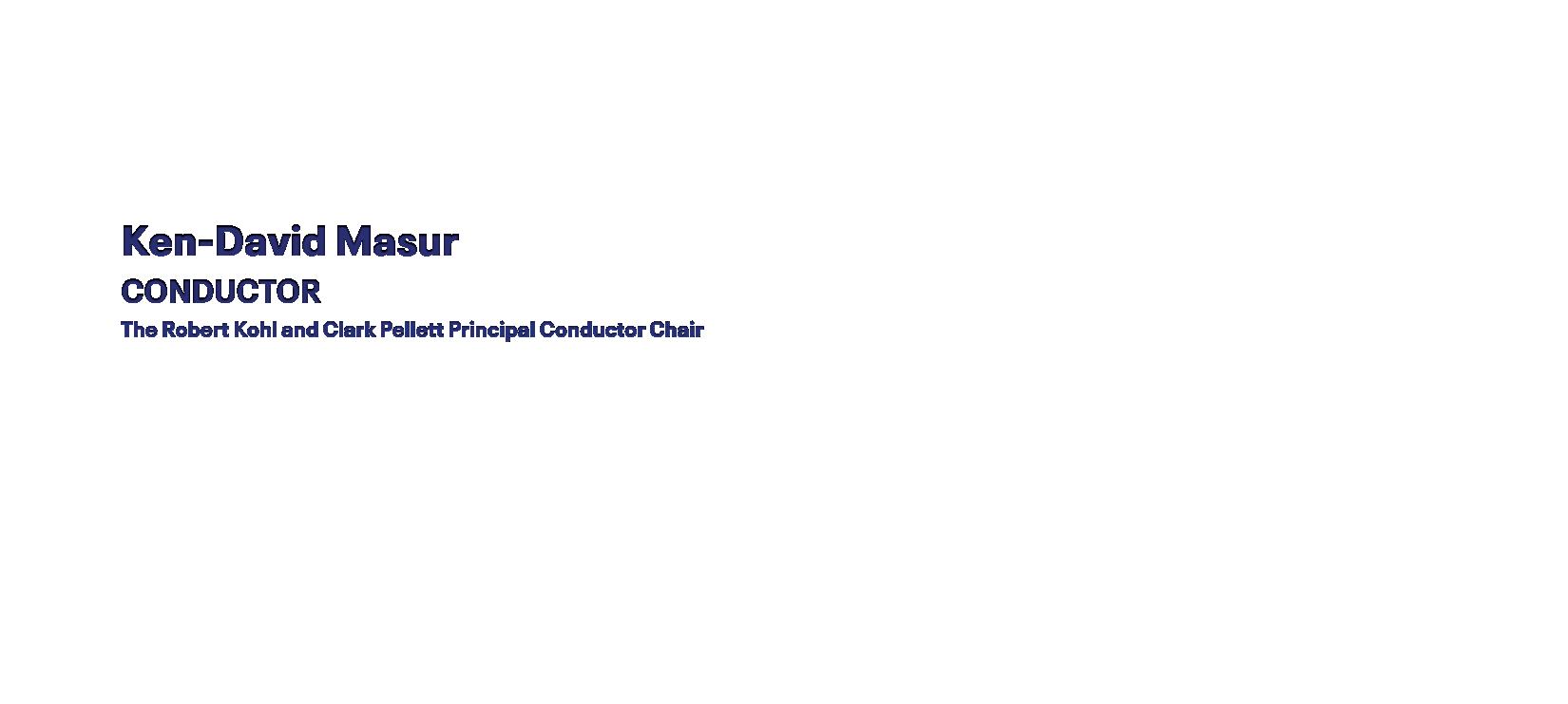
The 2023–24 Civic Orchestra season is generously sponsored by Lori Julian for the Julian Family Foundation, which also provides major funding for the Civic Fellowship program.
2
ONE HUNDRED FIFTH SEASON CIVIC ORCHESTRA OF CHICAGO
KEN-DAVID MASUR Principal Conductor
The Robert Kohl and Clark Pellett Principal Conductor Chair
Monday, April 8, 2024, at 7:30
Ken-David Masur Conductor
SIBELIUS
Symphony No. 7 in C Major, Op. 105 Adagio—Vivacissimo—Adagio— Allegro moderato—Adagio
INTERMISSION
PROKOFIEV
Symphony No. 5 in B-flat Major, Op. 100 Andante
Allegro moderato Adagio
Allegro giocoso
The 2023–24 Civic Orchestra season is generously sponsored by Lori Julian for the Julian Family Foundation, which also provides major funding for the Civic Fellowship program.
This project is supported in part by the National Endowment for the Arts.
The Civic Orchestra of Chicago acknowledges support from the Illinois Arts Council.
CSO.ORG 3
COMMENTS by Phillip Huscher
JEAN SIBELIUS
Born December 8, 1865; Tavastehus, Finland
Died September 20, 1957; Järvenpää, Finland
Symphony
No. 7 in C Major, Op. 105
COMPOSED
sketched: 1914–15
composed: 1923–24
FIRST PERFORMANCE
March 24, 1924; Stockholm, Sweden. The composer conducting
INSTRUMENTATION
two flutes with piccolo, two oboes, two clarinets, two bassoons, four horns, three trumpets, three trombones, timpani, strings
APPROXIMATE PERFORMANCE TIME
22 minutes

In the early 1920s, Sibelius’s career suddenly came to a close. Even though he would live another thirty-some years, he withdrew from the music scene where he once played a major role, preferring the seclusion of his villa in Järvenpää. His decision wasn’t inexplicable—it was, in fact, even predictable as he ventured further and further from the cutting-edge territory of Schoenberg and Stravinsky into his own dark and deeply personal world of sound. His final orchestral works, this Seventh
Symphony and the single tone poem, Tapiola, that followed it, carried Sibelius to the end of the line; we can scarcely imagine what music would logically have followed scores of such finality and stubborn originality. “Let no one imagine that composing is easier for an old composer if he takes his art seriously,” Sibelius once said. “Greater sureness makes one scorn solutions that come too easily.” The Seventh Symphony is an astonishing testament to his impatience with convention and his sheer determination to find new ways of saying things that mattered. By 1914, when Sibelius began to sketch this symphony, along with the Fifth and Sixth, his standards were already exceptionally high. And so all three of those symphonies are unlike any others ever written, and the seventh and last of them to be finished is so unclassifiable by the traditional names and forms that at the premiere, Sibelius called it a symphonic fantasy, only later admitting that it really belonged with the numbered symphonies. Actually, it’s the logical culmination of the series—the pure distillation of everything Sibelius
this page: Jean Sibelius, portrait, 1913, by Daniel Nyblin (1856–1923) | opposite page: Sibelius and his wife Aino (1871–1969) at Ainola, Järvenpää, 1915. Photo by Eric Sundström (1866–1933). Helsinki City Museum, Finland
4
knew about symphonic form and thought.
For all its individuality, the Seventh Symphony owes its conception to the traditional centuries-old search for symphonic unity. Like earlier influential works by Schubert, Liszt, Strauss, and Schoenberg, it is a multimovement form cast in one continuous movement. Sibelius makes passing reference to the familiar contents of the standard symphony—we hear stretches of a slow movement, part of a scherzo. It’s as if the conventional symphony has been taken apart and can’t be reassembled. In its place, Sibelius writes music that continually renews itself as it moves with great subtlety through various tempos (there are four big tempo changes and a number of lesser ones) and switches imperceptibly from each idea to the next, from one key to another. The Seventh Symphony is a work of epic majesty, stripped of all dross. The material is stern and concentrated; we sense just how desperate Sibelius was to write not a single note too many. The opening, for example, is built of the simplest of materials—the notes of the C major scale. But the way it begins (on A, following a quiet tap on the timpani) and leads to an ominous A-flat minor chord is full of mystery and rich in implications. As the music unfolds, it’s always unpredictable and, at the same time, utterly logical. Yet nothing about this symphony is haphazard; it’s governed by the certainty that each move is the right

one, even though, at every turn, Sibelius shows little concern for the conventional ideas of keys and subjects. A solo trombone melody, rising majestically from a great polyphonic web of sound near the beginning, carries great weight. It returns twice in the symphony, each time more insistent, and the last time leading to a massive, wrenching climax—like an ache in the very heart of the work. From there, the music slowly unravels, although the final gesture—a long, seemingly endless crescendo, reaching urgently up to C major—is like the last, life-affirming words of a dying man. It brings an extraordinary sense of closure to this restless, ever-questing music. This would seem to be the climax of his life’s work, yet Sibelius apparently began an eighth symphony sometime late in 1926 and worked on it until at least 1933 or 1934. Portions of the score were delivered to a copyist in 1933 but subsequently retrieved. The composer apparently destroyed the symphony in the 1940s. All that remains are three measures of sketches, labeled “Sinfonia 8 commincio,” that provide
CSO.ORG 5 COMMENTS
little sense of the symphony’s beginning, let alone its destination. Even though Sibelius had no new works to offer the public, his popularity continued to grow (in a 1935 poll, he was the favorite composer of the New York Philharmonic Society’s broadcast
SERGEI PROKOFIEV
audience). He remained a beloved— even revered—figure, and on his ninetieth birthday in 1955, he received 1,200 telegrams, tapes from Toscanini, and cigars from Churchill. He died in 1957, nearly thirty years after the publication of his last completed work.
Born April 23, 1891; Sontsovka, Ukraine Died March 5, 1953; Nikolina Gora, near Moscow, Russia
Symphony No. 5 in B-flat Major, Op. 100
COMPOSED
1944
FIRST PERFORMANCE
January 13, 1945; Moscow, Russia. The composer conducting
INSTRUMENTATION
two flutes and piccolo, two oboes and english horn, two clarinets, E-flat clarinet and bass clarinet, two bassoons and contrabassoon, four horns, three trumpets, three trombones, tuba, piano, harp, timpani, triangle, cymbals, tambourine, snare drum, woodblock, bass drum, tam-tam, strings
APPROXIMATE PERFORMANCE TIME
46 minutes
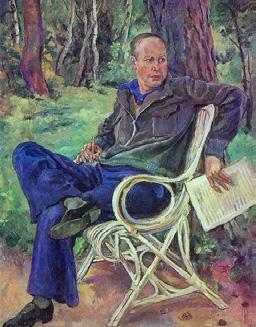
Sergei Prokofiev spent the summer of 1944 at a large country estate provided by the Union of Soviet Composers as a refuge from the war and as a kind of think tank. Prokofiev arrived early in the
summer and found that his colleagues included Glière, Shostakovich, Kabalevsky, Khachaturian, and Miaskovsky—summer camp for the most distinguished Soviet composers of the time.
Although Ivanovo, as the retreat was called, often was referred to as a rest home, there was little leisure once Prokofiev moved in. He maintained a rigorous daily schedule—as he had all his life—and began to impose it on the others as well. “The regularity with which he worked amazed us all,” Khachaturian later recalled. Prokofiev ate breakfast, marched to his studio to compose, and scheduled his walks and tennis games by the clock. In the evening, he insisted the composers all get together to compare notes, literally. Prokofiev was delighted, and clearly not surprised, that he usually had the most to show for his day’s work.
It was a particularly productive summer for Prokofiev—he composed both
6 COMMENTS
his Eighth Piano Sonata and the Fifth Symphony before he returned to Moscow. The sonata is prime Prokofiev and often played, but the symphony is perhaps the best known and most regularly performed of all his works. It had been fifteen years since Prokofiev’s last symphony, and both that symphony and the one preceding it had been by-products of theater pieces: the Third Symphony is musically related to the opera The Flaming Angel, and the Fourth to the ballet The Prodigal Son. Not since his Second Symphony, completed in 1925, had Prokofiev composed a purely abstract symphony or one that he began from scratch.
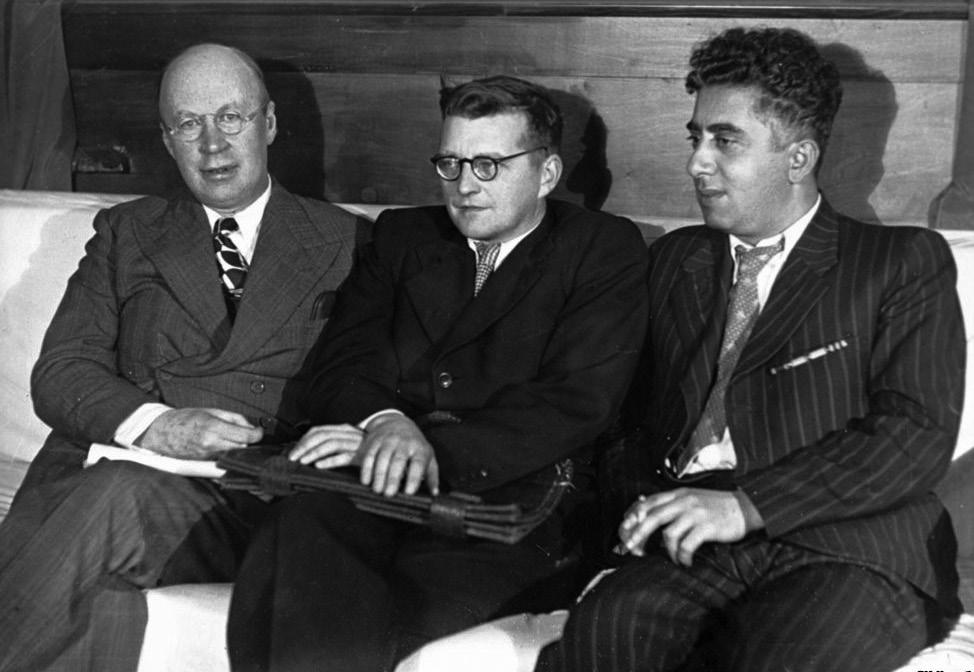
Although it was written at the height of the war, Prokofiev’s Fifth Symphony isn’t a wartime symphony in the traditional sense—not in the vivid and descriptive manner of Shostakovich’s Seventh, composed during the siege of Leningrad and written, in Carl Sandburg’s words, “with the heart’s blood”—or his Eighth, which coolly contemplates the horrors of war. (Those two scores date from 1941 and 1943, shortly before Prokofiev began this work.) Prokofiev’s Symphony no. 5 is intended to glorify the human spirit, “praising the free and happy man—his strength, his generosity, and the purity
of his soul.” In its own way, this outlook makes it an even greater product of the war because it was designed to uplift and console the Soviet people. “I cannot say I chose this theme,” Prokofiev wrote. “It was born in me and had to express itself.” Nonetheless, such optimistic and victorious music cheered the Russian authorities; it might well have been made to order. In his 1946 autobiography, Prokofiev writes: “It is the duty of the composer, like the poet, the sculptor, or the painter, to serve the rest of humanity, to beautify human life, and to point the way to a radiant future. Such is the immutable code of art as I see it.” It also was the code of art Soviet composers were expected to embrace during the war, but Prokofiev couldn’t have written a work as powerful and convincing as his Fifth Symphony if he didn’t truly believe those words.
The Fifth Symphony would inevitably be known as a victory celebration.
CSO.ORG 7 COMMENTS
opposite page: Sergei Prokofiev, in a portrait by Pyotr Konchalovsky (1876–1956), 1934 | this page: The composer (left), with Dmitri Shostakovich (center) and Aram Khachaturian (right), at the general assembly for the organizing committee of the Union of Soviet Composers, 1946
Just before the first performance, which Prokofiev conducted, word reached Moscow that the Russian army had scored a decisive victory on the Vistula River. As Prokofiev raised his baton, the sound of cannon was heard from the distance. Buoyed by both the news and the triumphant tone of the music, the premiere was a great success. It was the last time Prokofiev conducted in public. Three weeks later, he had a mild heart attack, fell down the stairs in his apartment, and suffered a slight concussion. Although he recovered his spirits—and eventually his strength and creative powers as well—Prokofiev continued to feel the effects of the accident for the remaining eight years of his life.
The first movement of the Fifth Symphony is intense and dramatic but neither aggressive nor violent, like much of the music written at the time. It is moderately paced (Prokofiev writes andante) and broadly lyrical throughout. The scherzo, in contrast, is quick and insistent, touched by a sense of humor that sometimes reveals a sharp, cutting edge. The third movement is lyrical and brooding, like much of Prokofiev’s finest slow music. After a brief and sober introduction, the finale points decisively toward a radiant future.
Phillip Huscher is the program annotator for the Chicago Symphony Orchestra.
8 COMMENTS
PROFILES
Ken-David Masur Conductor

Ken-David Masur celebrates his fifth season as music director of the Milwaukee Symphony Orchestra and principal conductor of the Chicago Symphony’s Civic Orchestra. He has conducted distinguished orchestras around the world, including the Chicago Symphony, Los Angeles Philharmonic, San Francisco Symphony, Orchestre National de France, Yomiuri Nippon Symphony, National Philharmonic of Russia, and other orchestras throughout the United States, France, Germany, Korea, Japan, and Scandinavia.
Masur’s tenure in Milwaukee has been marked by innovative thematic programming, including a festival celebrating the music of the 1930s, when the Bradley Symphony Center was built, and the Water Festival, which highlighted local community partners whose work centers on water conservation and education. He also instituted a multi-season artist-in-residence program and led highly acclaimed performances of major choral works, including a semistaged production of Peer Gynt.
This season, he begins a residency with bass-baritone Dashon Burton and leads the MSO in an inaugural citywide Bach festival, celebrating the diverse and universal appeal of J.S. Bach’s music in an ever-changing world.
Last season, Masur made his New York Philharmonic debut in a gala
program featuring John Williams and Steven Spielberg. He also debuted at the Pacific Music Festival in Sapporo, Japan, and at Classical Tahoe in three programs broadcast on PBS. He led the Boston Symphony Orchestra, Yo-Yo Ma, Itzhak Perlman, Branford Marsalis, and James Taylor at Tanglewood in a ninetieth birthday concert for John Williams. Summer 2023 marked Masur’s debuts with the Grant Park Festival and the National Repertory Orchestra; later this season, he returns to the Baltimore Symphony and the Kristiansand Symphony.
For eight years, Masur served as principal guest conductor of the Munich Symphony. He was also associate conductor of the San Diego Symphony and resident conductor of the San Antonio Symphony.
Music education and working with the next generation of young artists are of major importance to Masur. In addition to his work with the Civic Orchestra of Chicago, he has conducted Tokyo’s Bunka Kaikan Chamber Orchestra and Tanglewood Music Center Orchestra and led master classes at the University of WisconsinMilwaukee’s Peck School of the Arts, New England Conservatory, Manhattan School of Music, Boston University, Boston Conservatory, and the Juilliard School, where he leads the Juilliard Orchestra this fall.
Masur and his family are proud to call Milwaukee their home and enjoy exploring all the riches of the Third Coast.
PHOTO BY ADAM DETOUR
CSO.ORG 9
Civic Orchestra of Chicago
Founded in 1919 by Frederick Stock, second music director of the Chicago Symphony Orchestra (CSO), the Civic Orchestra of Chicago prepares emerging professional musicians for lives in music. Civic members participate in rigorous orchestral training, September through June each season, with the Robert Kohl and Clark Pellett Principal Conductor Ken-David Masur, musicians of the CSO, and some of today’s most luminary conductors, including Riccardo Muti, the CSO’s music director emeritus for life.
The importance of the Civic Orchestra’s role in Greater Chicago is underscored by its commitment to present concerts of the highest quality at no charge to the public. In addition to the critically acclaimed live concerts at Symphony Center, Civic Orchestra performances can be heard locally on WFMT (98.7 FM).
Civic musicians also expand their creative, professional, and artistic boundaries and reach diverse audiences through educational performances at Chicago Public Schools and a series of chamber concerts at various locations throughout the city, including Chicago Park District fieldhouses and the National Museum of Mexican Art.
To further expand its musician training, the Civic Orchestra launched the Civic Fellowship program in the
2013–14 season. Each year, ten to fifteen Civic members are designated as Civic Fellows and participate in intensive leadership training that is designed to build and diversify their creative and professional skills.
From 2010 to 2019, Yo-Yo Ma was a leading mentor to Civic musicians and staff in his role as CSO Judson and Joyce Green Creative Consultant, and the programs and initiatives he established are integral to the Civic Orchestra curriculum today. Civic Orchestra musicians develop as exceptional orchestral players and engaged artists, cultivating their ability to succeed in the rapidly evolving world of music in the twenty-first century.
The Civic Orchestra’s long history of presenting full orchestra performances free to the public includes annual concerts at the South Shore Cultural Center (in partnership with the South Shore Advisory Council) as well as numerous Chicago Public Schools. The Civic Orchestra is a signature program of the Negaunee Music Institute at the Chicago Symphony Orchestra, which offers a wide range of education and community programs that engage more than 200,000 people of diverse ages, incomes, and backgrounds each year in Chicago and around the world.
For more on the Civic Orchestra of Chicago and its Principal Conductor Ken-David Masur, please visit cso.org/civic.
10 PROFILES
Civic Orchestra of Chicago
Ken-David Masur Principal Conductor
The Robert Kohl and Clark Pellett Principal Conductor Chair
VIOLINS
Ran (Ryan) Huo
Mona Munire Mierxiati
Jonah Kartman
Sheena Lan
Kimberly Bill
Elise Maas
Alec Tonno
Hojung Christina Lee
Darren Carter
Isabelle Chin
Nelson Mendoza
Lina Yamin*
Annie Pham
Danira Rodríguez-Purcell
Janani Sivakumar
Marian Antonette Mayuga*
Heewoo Seo
Hobart Shi
Matthew Weinberg
Matthew Musachio*
Valentina Guillen Menesello
Sean Hsi
J. Andrés Robuschi
Justine Teo
Megan Pollon
Alba Layana Izurieta
VIOLAS
Sanford Whatley
Michael Ayala
Sava Velkoff
Carlos Lozano
Derrick Ware
Justin Pou
Junghyun Ahn
Megan Yeung
Elena Galentas
Santiago Del Castillo
Lucie Boyd
Rebecca Miller
CELLOS
David Caplan
Miles Link
Lidanys Graterol
Buianto Lkhasaranov
J Holzen*
Francisco Lopez Malespin*
Lindsey Sharpe
Niraj Patil
Cameron Slaugh
Chad Polk
BASSES
Ben Foerster*
Hannah Novak
Broner McCoy
James O’Toole
Tiffany Kung
Leo Finan
Daniel W. Meyer
Walker Dean
FLUTES
Aalia Hanif*
Jungah Yoon
Katarina Ignatovich
PICCOLOS
Aalia Hanif*
Jungah Yoon
OBOES
James Kim
Natalie Johnson
ENGLISH HORN
Hannah Fusco
CLARINETS
Elizabeth Kapitaniuk
Amy Hur*
E-FLAT CLARINET
Tyler Baillie
BASS CLARINET
Nathan Vilhena Kock
* Civic Orchestra Fellow
BASSOONS
Ian Arthur Schneiderman
Seo Young (Michelle) Min
CONTRABASSOON
William George
HORNS
Asunción Martínez
Ryan Williamson
Loren Ho
TRUMPETS
Sean-David Whitworth
Kai-Chun Chang
Abner Wong
TROMBONES
Hugo Saavedra* Jihong Son
BASS TROMBONE
Alexander Mullins
TUBA
Ben Poirot
TIMPANI
Tomas Leivestad
PERCUSSION
Charley Gillette
Alex Chao
Sehee Park
Dominik McDonald
Karel Zambrano
HARP
Janna Young
KEYBOARD
Wenlin Cheng
LIBRARIAN
Benjimen Neal
CSO.ORG 11
PROFILES
NEGAUNEE MUSIC INSTITUTE AT THE CSO
the board of the negaunee music institute
Leslie Burns Chair
Steve Shebik Vice Chair
John Aalbregtse
David Arch
James Borkman
Jacqui Cheng
Ricardo Cifuentes
Richard Colburn
Dunni Cosey Gay
Charles Emmons
Judy Feldman
Lori Julian
Toni-Marie Montgomery
Rumi Morales
Mimi Murley
Margo Oberman
Gerald Pauling
Harper Reed
Veronica Reyes
Marlon Smith
Eugene Stark
Liisa Thomas
Ex-officio Members
Jeff Alexander
Jonathan McCormick
Vanessa Moss
civic orchestra
artistic leadership
Ken-David Masur Principal Conductor
The Robert Kohl and Clark Pellett
Principal Conductor Chair
Coaches from the Chicago Symphony Orchestra
Robert Chen Concertmaster
The Louis C. Sudler Chair, endowed by an anonymous benefactor
Baird Dodge Principal
Second Violin
Danny Lai Viola
Max Raimi Viola
John Sharp Principal Cello
The Eloise W. Martin Chair
Kenneth Olsen Assistant
Principal Cello
The Adele Gidwitz Chair
Richard Hirschl Cello
Daniel Katz Cello
Brant Taylor Cello
Alexander Hanna Principal Bass
The David and Mary Winton
Green Principal Bass Chair
Stefán Ragnar Höskuldsson
Principal Flute
The Erika and Dietrich M. Gross
Principal Flute Chair
Emma Gerstein Flute
Jennifer Gunn Flute and Piccolo
The Dora and John Aalbregtse Piccolo Chair
William Welter Principal Oboe
The Nancy and Larry Fuller
Principal Oboe Chair
Stephen Williamson
Principal Clarinet
John Bruce Yeh Assistant
Principal Clarinet and E-flat Clarinet
Keith Buncke Principal Bassoon
William Buchman Assistant
Principal Bassoon
Mark Almond Principal Horn
Daniel Gingrich Horn
Esteban Batallán
Principal Trumpet
The Adolph Herseth Principal
Trumpet Chair, endowed by an anonymous benefactor
Mark Ridenour Assistant
Principal Trumpet
John Hagstrom Trumpet
The Bleck Family Chair
Tage Larsen Trumpet
The Pritzker Military Museum & Library Chair
Michael Mulcahy Trombone
Charles Vernon Bass Trombone
Gene Pokorny Principal Tuba
The Arnold Jacobs Principal Tuba Chair, endowed by Christine Querfeld
David Herbert Principal Timpani
The Clinton Family Fund Chair
Vadim Karpinos Assistant
Principal Timpani, Percussion
Cynthia Yeh Principal Percussion
Sarah Bullen Former
Principal Harp
Mary Sauer Former
Principal Keyboard
Justin Vibbard Principal Librarian
negaunee music institute at the cso
Jonathan McCormick Director, Education & the Negaunee Music Institute
Katy Clusen Associate Director, CSO for Kids
Rachael Cohen Program Manager
Antonio Padilla Denis Manager, Civic Orchestra of Chicago
Katie Eaton Coordinator, School Partnerships
Mona Wu Operations Coordinator, Civic Orchestra of Chicago
Jackson Brown Program Assistant
Carol Kelleher Assistant, CSO for Kids
Frances Atkins Content Director
Kristin Tobin Designer & Print Production Manager
Petya Kaltchev Editor
12
HONOR ROLL OF DONORS
Negaunee Music Institute at the Chicago Symphony Orchestra
The Negaunee Music Institute connects individuals and communities to the extraordinary musical resources of the Chicago Symphony Orchestra. The following donors are gratefully acknowledged for making a gift in support of these educational and engagement programs. To make a gift or learn more, please contact Kevin Gupana, Associate Director of Giving, Educational and Engagement Programs, 312-294-3156.
$150,000 AND ABOVE
Lori Julian for The Julian Family Foundation
The Negaunee Foundation
$100,000–$149,999
Anonymous
Allstate Insurance Company
$75,000–$99,999
John Hart and Carol Prins
Barbara and Barre Seid Foundation
Megan and Steve Shebik
$50,000–$74,999
Anonymous
BMO
Robert and Joanne Crown Income Charitable Fund
Lloyd A. Fry Foundation
Judy and Scott McCue
Polk Bros. Foundation
Michael and Linda Simon
Lisa and Paul Wiggin
$35,000–$49,999
Bowman C. Lingle Trust
National Endowment for the Arts
The George L. Shields Foundation, Inc.
Shure Charitable Trust
$25,000–$34,999
Anonymous
Abbott Fund
Carey and Brett August
Crain-Maling Foundation
Kinder Morgan
Margo and Michael Oberman
Gene and Jean Stark
$20,000–$24,999
Anonymous
Mary Winton Green
Halasyamani/Davis Family Illinois Arts Council Agency
Richard P. and Susan Kiphart Family
PNC
Charles and M. R. Shapiro Foundation
$15,000–$19,999
Nancy A. Abshire
Robert & Isabelle Bass Foundation, Inc.
The Buchanan Family Foundation
John D. and Leslie Henner Burns
Bruce and Martha Clinton for The Clinton Family Fund
Sue and Jim Colletti
Mr. Philip Lumpkin
The Maval Foundation
Sandra and Earl Rusnak, Jr. † Dr. Marylou Witz
$11,500–$14,999
Barker Welfare Foundation
Mr. † & Mrs. David A. Donovan
Mrs. Carol Evans, in memory of Henry Evans
Ksenia A. and Peter Turula
$7,500–$11,499
Anonymous
Robert H. Baum and MaryBeth Kretz
Mr. Lawrence Corry
Nancy and Bernard Dunkel
Ellen and Paul Gignilliat
Mr. & Mrs. Joseph B. Glossberg
Chet Gougis and Shelley Ochab
JPMorgan Chase & Co.
The League of the Chicago Symphony Orchestra Association
Mr. Glen Madeja and Ms. Janet Steidl
Dr. Leo and Catherine Miserendino
Ms. Susan Norvich
Ms. Emilysue Pinnell
D. Elizabeth Price
LTC. Jennifer N. Pritzker, USA (Ret.)
Benjamin J. Rosenthal Foundation
Ms. Courtney Shea
Ms. Liisa M. Thomas and Mr. Stephen L. Pratt
Theodore and Elisabeth Wachs
Catherine M. and Frederick H. Waddell
$4,500–$7,499
Anonymous
Joseph Bartush
Ann and Richard Carr
Harry F. and Elaine Chaddick Foundation
Mary and Lionel Go
Constance M. Filling and Robert D. Hevey, Jr.
Dr. June Koizumi
Dr. Lynda Lane
Francine R. Manilow
Leoni Zverow McVey and Bill McVey
Jim and Ginger Meyer
Drs. Robert and Marsha Mrtek
The Osprey Foundation
Dr. Scholl Foundation
$3,500–$4,499
Anonymous
Arts Midwest Gig Fund
Charles H. and Bertha L. Boothroyd Foundation
Dr. Edward A. Cole and Dr. Christine A. Rydel
Mr. & Mrs. Dwight Decker
Judith E. Feldman
Camillo and Arlene Ghiron
Ms. Dawn E. Helwig
Ms. Ethelle Katz
Robert J. Richards and Barbara A. Richards
Mr. Peter Vale
Ms. Mary Walsh
$2,500–$3,499
Anonymous
Dora J. and R. John Aalbregtse
David and Suzanne Arch
Mr. James Borkman
Adam Bossov
Mr. Douglas Bragan †
Mr. Ray Capitanini
Lisa Chessare
Mr. Ricardo Cifuentes
Patricia A. Clickener
Ms. Nancy Dehmlow
CSO.ORG 13
HONOR ROLL OF DONORS
Mr. Clinton J. Ecker and Ms. Jacqui Cheng
William B. Hinchliff
Michael and Leigh Huston
Italian Village Restaurants
Ms. Mirjana Martich and Mr. Zoran Lazarevic
Mrs. Frank Morrissey
David † and Dolores Nelson
Mr. & Mrs. Jeffery Piper
Lee Ann and Savit Pirl
Mr. & Mrs. Stephen Racker
Erik and Nelleke Roffelsen
Mr. David Sandfort
Gerald and Barbara Schultz
Jessie Shih and Johnson Ho
Dr. & Mrs. R. Solaro
Carol S. Sonnenschein
Mr. † & Mrs. Hugo Sonnenschein
Ms. Joanne C. Tremulis
Mr. Kenneth Witkowski
Ms. Camille Zientek
$1,500–$2,499
Ms. Marlene Bach
Ms. Barbara Barzansky
Mr. Lawrence Belles
Mr. & Mrs. William E. Bible
Cassandra L. Book
Mr. Donald Bouseman
Ms. Danolda Brennan
Mr. Lee M. Brown and Ms. Pixie Newman
Darren Cahr
Bradley Cohn
Charles and Carol Emmons
Dr. & Mrs. Sanford Finkel, in honor of the Civic horn section
Mr. Conrad Fischer
Ms. Lola Flamm
David and Janet Fox
Ronald and Diane Hamburger
Mr. † & Mrs. Robert Heidrick
Thomas and Reseda Kalowski
Mr. & Mrs. Norman Koglin
Dona Le Blanc
Adele Mayer
Mr. Aaron Mills
Mr. & Mrs. Stephen Morales
Mr. & Mrs. Robert S. Murley
Mr. Alexander Ripley
Ms. Mary Sauer
Mr. & Mrs. Thomas Scorza
Jane A. Shapiro
Mrs. Julie Stagliano
Michael and Salme Steinberg
Walter and Caroline Sueske Charitable Trust
Ayana Tomeka
Ms. Betty Vandenbosch
Abby and Glen Weisberg
M.L. Winburn
Irene Ziaya and Paul Chaitkin
Dr. & Mrs. Larry Zollinger
$1,000–$1,499
Anonymous
Duffie A. Adelson
John Albrecht
Ms. Rochelle Allen
Ms. Margaret Amato
Allen and Laura Ashley
Howard and Donna Bass
Daniel and Michele Becker
Ann Blickensderfer
Mr. Rowland Chang
David Colburn
Mr. & Mrs. Bill Cottle
Alan R. Cravitz
Mr. & Mrs. Barnaby Dinges
Tom Draski
DS&P Insurance Services, Inc.
Ms. Sharon Eiseman
Richard Finegold, M.D. and Ms. Rita O’Laughlin
Foxman Family Foundation
Eunice and Perry Goldberg
Enid Goubeaux
Mrs. Susan Hammond
Dr. Robert A. Harris
Mr. David Helverson
Clifford Hollander and Sharon Flynn Hollander
Dr. Ronald L. Hullinger
Dr. Victoria Ingram and Dr. Paul Navin
Mr. Ray Jones
Charles Katzenmeyer
Cantor Aviva Katzman and Dr. Morris Mauer
Randolph T. Kohler and Scott Gordan
Ms. Foo Choo Lee
Dr. & Mrs. Stuart Levin
Mr. † & Mrs. Gerald F. Loftus
Timothy Lubenow
Sharon L. Manuel
Rosa and Peter McCullagh
Mr. & Mrs. William McNally
Robert O. Middleton
Stephen W. and Kathleen J. Miller
Geoffrey R. Morgan
Mrs. MaryLouise Morrison
Catherine Mouly and LeRoy T. Carlson, Jr.
Lewis Nashner
William H. Nichols
Ms. Sylvette Nicolini
Edward and Gayla Nieminen
Mr. Bruce Oltman
Ms. Joan Pantsios
Kirsten Bedway and Simon Peebler
Ms. Dona Perry
James † and Sharon Phillips
Christine and Michael Pope
Quinlan & Fabish
Mr. George Quinlan
Susan Rabe
Dr. Hilda Richards
Dr. Edward Riley
Mary K. Ring
Christina Romero and Rama Kumanduri
Mr. & Mrs. Richard Rosenberg
Mr. & Mrs. Jeffrey Ross
Mr. David Samson
Peter Schauer
Mr. David M. Schiffman
Barbara and Lewis Schneider
Mr. & Mrs. Steve Schuette
Stephen A. and Marilyn Scott
Mr. Rahul and Mrs. Shobha Shah
Mr. & Mrs. James Shapiro
Dr. Rebecca Sherrick
Mr. Larry Simpson
Dr. Sabine Sobek
Ms. Denise Stauder
Mrs. Pamela Stepansky
Mr. & Mrs. Ronald Stepansky
Donna Stroder
Sharon Swanson
Dr. Douglas Vaughan
Mr. & Mrs. Richard Waxman
Mr. & Mrs. Joel Weisman
Joni Williams
Jane Stroud Wright
ENDOWED FUNDS
Anonymous (3)
Cyrus H. Adams Memorial Youth Concert Fund
Dr. & Mrs. Bernard H. Adelson Fund
Marjorie Blum-Kovler Youth Concert Fund
CNA
The Davee Foundation
Frank Family Fund
14
Kelli Gardner Youth Education Endowment Fund
Jennifer Amler Goldstein Fund, in memory of Thomas M. Goldstein
Mary Winton Green
William Randolph Hearst Foundation Fund for Community Engagement
Richard A. Heise
Peter Paul Herbert Endowment Fund
Julian Family Foundation Fund
The Kapnick Family
Lester B. Knight Charitable Trust
The Malott Family School Concerts Fund
The Eloise W. Martin Endowed Fund in support of the Negaunee Music Institute at the Chicago Symphony Orchestra
The Negaunee Foundation
Nancy Ranney and Family and Friends
Shebik Community Engagement Programs Fund
Toyota Endowed Fund
The Wallace Foundation
Zell Family Foundation
CIVIC ORCHESTRA OF CHICAGO SCHOLARSHIPS
Members of the Civic Orchestra receive an annual stipend to help offset some of their living expenses during their training in Civic. The following donors have generously underwritten a Civic musician(s) for the 2023–24 season.
Eleven Civic members participate in the Civic Fellowship program, a rigorous artistic and professional development curriculum that supplements their membership in the full orchestra. Major funding for this program is generously provided by Lori Julian for the Julian Family Foundation.
Nancy A. Abshire
Amanda Kellman, viola
Dr. & Mrs. Bernard H. Adelson Fund
Megan Yeung, viola
Sue and Jim Colletti
Nina Laube,* bassoon
Lawrence Corry
Jonah Kartman, violin
Robert and Joanne Crown Income Charitable Fund
Charley Gillette, percussion
James Kim, oboe
Buianto Lkhasaranov, cello
Daniel W. Meyer, bass
Subin Shin, violin
Abner Wong, trumpet
Mr. † & Mrs. David A. Donovan
Jacob Medina, horn
Mr. & Mrs. Paul C. Gignilliat
Janani Sivakumar, violin
Mr. & Mrs. Joseph B. Glossberg
Hannah Novak, bass
Richard and Alice Godfrey
Matthew Weinberg, violin
Jennifer Amler Goldstein Fund, in memory of Thomas M. Goldstein
Alex Chao, percussion
Chet Gougis and Shelley Ochab
Tomas Leivestad, timpani
Mary Winton Green
Victor Stahoviak, bass
Jane Redmond Haliday Chair Mona Munire Mierxiati, violin
Lori Julian for the Julian Family Foundation
Nelson Mendoza, violin
Lina Yamin, violin
Lester B. Knight Charitable Trust
Valentina Guillen Menesello, violin
Elizabeth Kapitaniuk, clarinet
Elise Maas, violin
Ryan Williamson, horn
Brandon Xu, cello
HONOR ROLL OF DONORS
League of the Chicago Symphony Orchestra Association
Lindsey Sharpe, cello
Leslie Fund Inc.
Francisco Lopez Malespin,* cello
Phil Lumpkin
Matthew Musachio,* violin
Glenn Madeja and Janet Steidl
Abigail Monroe, cello
The Maval Foundation
Mark Morris, horn
Felix Regalado, trombone
Judy and Scott McCue and the Leslie Fund Inc.
Aalia Hanif,* flute
Dr. Leo and Catherine Miserendino
Sean-David Whitworth, trumpet
Ms. Susan Norvich
Nick Collins,* tuba
Ben Poirot, tuba
Margo and Mike Oberman
Ben Foerster,* bass
Sandra and Earl J. Rusnak, Jr. †
Quincy Erickson, trumpet
Barbara and Barre Seid Foundation
Alexander Mullins, bass trombone
Hugo Saavedra,* trombone
The George L. Shields Foundation, Inc.
Hsuan Chen, violin
Carlos Lozano, viola
Cameron Slaugh, cello
David W. and Lucille G. Stotter Chair
Ran (Ryan) Huo, violin
Ruth Miner Swislow Charitable Fund
Kimberly Bill, violin
CSO.ORG 15
HONOR ROLL OF DONORS
Lois and James Vrhel
Endowment Fund
Broner McCoy, bass
Theodore and Elisabeth Wachs
Hae Sol (Amy) Hur,+ clarinet
† Deceased * Civic Orchestra Fellow
Gifts listed as of February 2024
Dr. Marylou Witz
Marian Antonette Mayuga, violin
Anonymous
Anonymous Hojung Christina Lee, violin
Anonymous J Holzen,* cello
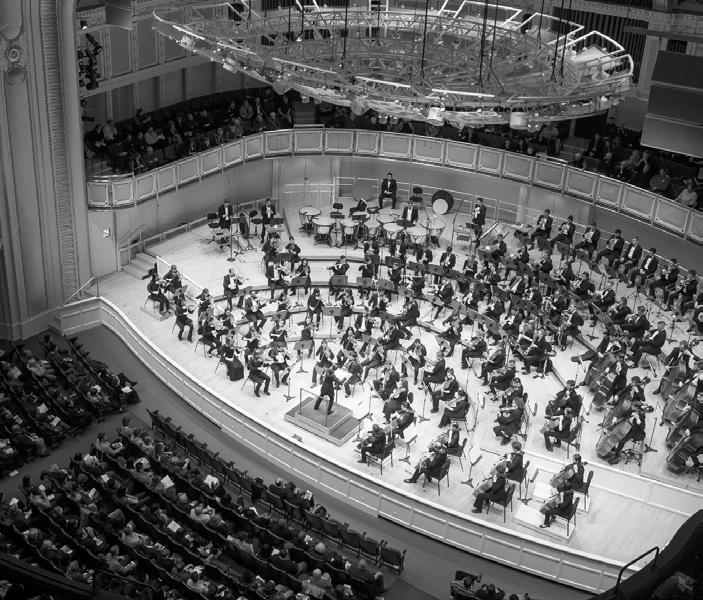
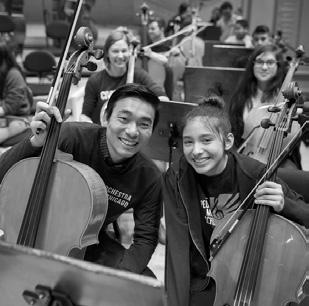
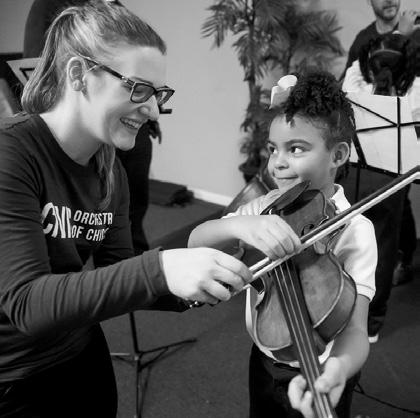
A gift to the Civic Orchestra of Chicago supports the rigorous training that members receive throughout the season, which includes coaching from musicians of the Chicago Symphony Orchestra and world-class conductors.
Your gift today ensures that the Chicago Symphony Orchestra Association will continue to enrich, inspire and transform lives through music.
A gift to the Civic Orchestra of Chicago supports the rigorous training that members receive throughout the season, which includes coaching from musicians of the Chicago Symphony Orchestra and world-class conductors.
CSO.ORG/GIVETOCIVIC
312 -294 - 3100
Your gift today ensures that the Chicago Symphony Orchestra Association will continue to enrich, inspire and transform lives through music.
CSO.ORG/GIVETOCIVIC
312-294-3100

SCAN TO GIVE
















